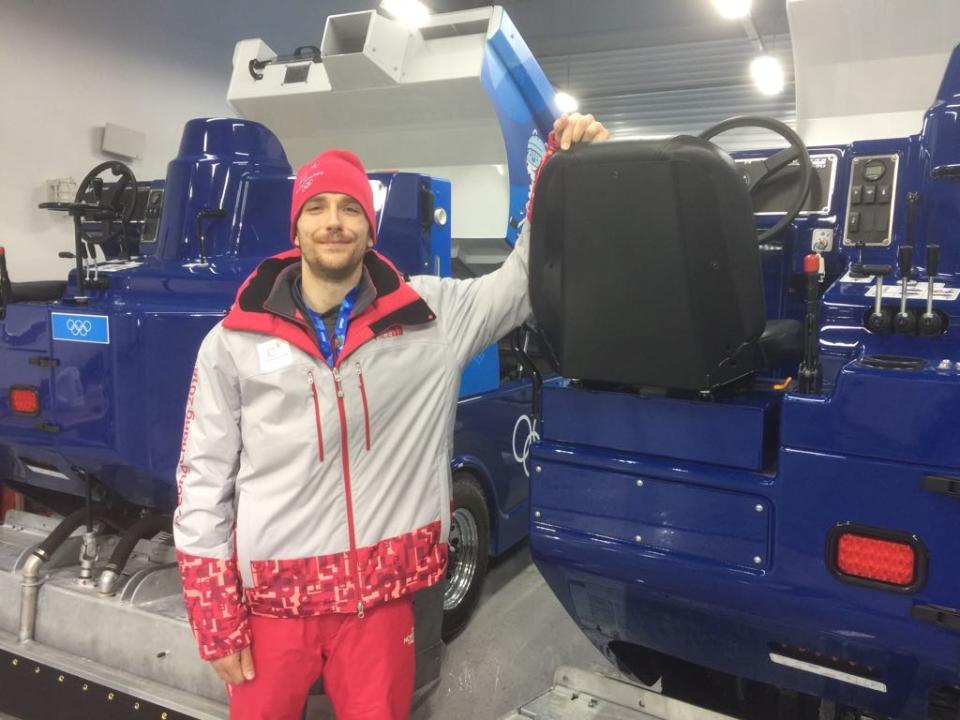NHL players aren't at these Olympics, but their Zamboni drivers are here
PYEONGCHANG, South Korea – Don’t believe anyone who tells you the NHL isn’t here. The NHL has sent the very best to the Olympics.
The very best Zamboni drivers.
They are called ice technicians, and even though it looks like a joyride to wheel around a rink in a giant ice-making machine, it’s actually a very specialized task.
So specialized that South Korea simply didn’t have the experienced people to do the job on the world stage.
“There’s not a lot of skating [in South Korea] in general,” said Ryan Hevern, 26, who is here from Saint Paul, Minnesota. “They tried to have them do it at first, last year, then they realized they needed to call in bigger help.”

Enter the all-stars of the NHL.
In fairness, not all of the ice techs here work at league rinks. But Hevern does. On Monday he was stationed at the training rink where Team USA skated through practice before its first match on Wednesday. Hevern’s dad was also a Zamboni driver and taught Ryan the trade after he got done with high school. He started driving at Xcel Energy Center — where the Minnesota Wild play — in 2014.
Hevern talks Zambonis with the same exuberance that Tony Romo talks football play-calling.
“Shave, wash and flood,” he said, going through the three principles of great ice. “Straight lines look nice. You gotta read the ice. You need to know what the temperature on the surface is and what the temperature on the base is. You gotta listen to them when they’re skating to know whether to adjust the compressors, turn it colder, or let it heat up a little.”
This is not easy stuff. It takes years of training and the Koreans didn’t have that kind of time. So the PyeongChang Olympic Committee brought in Colorado’s Don Moffatt to be Chief Ice Maker. (Yes, that’s his title.) He’s the wizard with 31 years of experience who handles everything from the Olympics to the NHL outdoor games. “When ice needs to be made,” Hevern said, “they call in Don Moffatt.”
And Moffatt called in Hevern, along with seven other techs from North America. The three from Minnesota are staying in one hotel triplex (call it Club Zamboni) and having a blast.
But, again, this is no junket. The world is watching and Hevern easily goes into shoptalk whenever he can.
“There’s a window on the dump tank where the snow is shot into,” he explains. “You can gauge by how it’s filling how much you’re shaving. You don’t want to overfill. You want to go at a sufficient speed so that you don’t run out of water to make it look glossy. It’s about timing.”
There’s even the occasional game film. Hevern says he notices when he sees footage of another driver leaving the dreaded “Nike Swoosh” of unmade ice in his wake. He says that comes from not paying attention and “rocking the wheel too much.” Worse still is when the blade is dropped too low and too much snow rockets up into the tank. Then you have to leave the ice, dump the snow and take the “victory lap” for all to see. Hevern says Minnesotans are so smart about ice that they jeer when they see this.
The nightmare scenario? At the 2006 Olympics, large holes developed in the ice only a matter of hours before faceoff in Torino, Italy. It was Moffatt who had to fix it in a pinch.

The Zambonis in Korea are actually new models built in Canada. It’s an adjustment for Hevern and the others, as some of the controls are on the right side of the steering wheel instead of the left. That matters more than you’d think, as drivers can’t see the ice directly in front of them. So a lot of what they do is based on feel and muscle memory.
“You develop a sixth sense,” Hevern said. “You’re sitting in the back. You have to know when to turn.”
There’s no fame in being an ice tech. There are no Zamboni groupies. It’s kind of like being an umpire in baseball: the goal is to not be the center of attention. If the commentators on NBC are talking about the ice, it’s almost always a bad thing. “We’re kind of behind-the-scenes people,” Hevern says.
But they are invaluable, especially here. Gold is on the line, along with all sorts of national pride, and no one wants a crucial goal to be determined by a lost edge or a cheap bounce. If you think about it, the games can go on without NHL players but not without NHL-quality ice.
So Hevern is drinking it all in, paid to travel to the Olympics and do the job he relishes. He’ll probably take a moment to look up during one of his runs and see little kids staring at him with awe. Maybe there will be a generation of ice techs here who become inspired by what they see in between periods instead of during them. That’s how Hevern got hooked, and he is only looking back in the literal sense — back to make sure the ice looks like glass.
“I think I’ll be doing this the rest of my life,” he said.
More from Yahoo Sports:
• The incredible story of Red Gerard, new teenage snowboarding hero
• Wardrobe malfunction mars routine of South Korean ice dancers
• Gus Kenworthy out, proud, and not holding back from VP Pence
• IOC member: Joint Korean hockey team should win Nobel Peace Prize
• How Russia’s Olympic fans are making a mockery of the IOC


